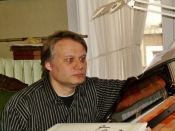DE PILLECYN Jurgen (1965)
Jurgen De Pillecyn was born on 20 January 1965 in Hamme. He studied piano, percussion and harmony at the music academies in Hamme and Leuven. In 1982 he entered the musicology programme at the Katholieke Universiteit Leuven, earning his degree in 1986 (magna cum laude). His thesis dealt with the influence of Robert Schumann’s work on the music of Johannes Brahms. In 1986 – while still at university – he began music studies at the Royal Conservatory in Brussels, initially taking courses in music theory and composition, including counterpoint and fugue, for which he earned a first prize in 1989. From that moment he began to compose. He also took courses in orchestration and analysis, graduating in 2000 (magna cum laude) in the class of Rafaël D’Haene.
Since graduating, he has composed for various scorings. Among his works are compositions for piano, organ works, vocal works, chamber music and symphonic works. De Pillecyn has regularly composed commissioned works, for such organisations as the Axion Classics National Music Competition, the Dinant International Competitiion for Saxophone and the Flemish Community. Jurgen De Pillecyn has taught at the Royal Conservatory in Brussels since 1989 and also teaches at the municipal music academy in Schaarbeek. De Pillecyn is a member of the Robert Schumann Gesellschaft in Dusseldorf.
Work
Jurgen De Pillecyn’s oeuvre shows a clear link with traditional compositional methods. He writes for such standard scorings as string quartet, solo instrument or voice with piano accompaniment, symphony orchestra and piano trio. New playing techniques are rarely applied and the scores make use of traditional music notation. De Pillecyn takes his place securely within the tradition of classical thematic thinking, using the development of thematic material as the main unifying and structuring element in his compositions. A good example of this approach is the organ work Per gli laudesi, which is entirely based on 2 contrasting main themes and 2 secondary themes.
In Jurgen De Pillecyn’s work, melody and harmony are the result of improvisation at the piano. The harmonic framework in which his compositions unfolds is, however, not tonal. There is no specific system of tonal organisation, an idea that the composer sees as limiting. His harmonic language can thus best described as free-atonal. In this sense, his work may be related to the music of the Polish composer Karol Szymanowsky and the French composer Henri Dutilleux. Harsh dissonances are deliberately avoided, based on De Pillecyn’s conviction that music should please the audience and be interesting for both the connoisseur and the music-lover. As with the thematic material, the composer creates coherence through the harmonic basis of his compositions. He does this partly by applying chords or note combinations in a structural way through a composition, repeating them in various different positions.
He sometimes uses modal systems. In Preludio per gli laudesi, for example, the following mode forms the harmonic basis for the work: c-sharp – d – e – f – g – a – b – c-sharp. Jurgen De Pillecyn also emphasises counterpoint in his work as a teacher of composition, explicitly applying it as a counter-balance to his highly thematic and harmonic approach. This is illustrated by the symphonic work Livre d’Heures, in which a first movement with a strong melodic-thematic basis is followed by a contrapuntal second movement. Counterpoint is also emphatically present in the organ work Preludio per gli laudesi (2001).
A literary source of inspiration often forms the point of departure for De Pillecyn’s compositional process; he prefers this to wholly abstract-structural works. The composer’s literary interest has been mainly stimulated by the fact that his great uncle, Filip De Pillecyn, was a Flemish writer whose works he came to know early on, along with those of other Flemish writers such as Karel Van De Woestijne. The creation of mood and drawing of characters are expression techniques frequently found in his work. The influence of Robert Schumann, one of De Pillecyn’s greatest examples, is of course significant here. His music cannot, however, be described as truly ‘narrative’. It is, rather, the composer’s intention to create a particular mood, inspired by a work of literature. For instance, in Wintermuggen (Winter midges) for soprano, clarinet and piano, on a text by Guido Gezelle, he uses the piano part to recreate the atmosphere of a snowy winter landscape. The titles that he gives to works are also indicative of this approach. The Second String Quartet, Les lumières du délier consists of 9 sections all with titles that conjure up a particular mood. The title of the second section, for instance, is “Verlatenheid… Lontanaza” (Abandonment…distance), and the the sixth is called “Droom en gelatenheid…intimo” (Dream and resignation…intimate). His Athena Parthenos is another work in which this link is clearly evident.
List of works
Chamber: Trio for violin, violoncello and piano (1995); Sonatina for piano (1996); Pittoresque for flute and piano (1997); String Quartet no. 1 (1998); Athena Parthenos for flute and piano (2001); String Quartet no. 2 “Les lumières du délire” (2003); D’un jardin secret for violin and piano (2004)
Songs: Twee liederen op tekst van Karel Van de Woestijne (1989); Wintermuggen, for soprano, clarinet, piano, on text by Guido Gezelle (1999); Stille zangen, on text by Karel Van de Woestijne (2001)
Organ: Suoni ostinati, organ and trumpet (1996); Preludio per gi Laudesi (2001)
Symphonic: Temperamenti (3 parts) (2000); Livre d’heures, symphonic impressions after Masereel (2002)
Bibliography
– H. DE BACKER, Preludio “Per gli laudesi” van Jurgen De Pillecyn, in Orgelkunst, uitg. dr. Orgelkunst vzw, jg. 27 nr. 3, 2004, p. 171-174
Discography
– Wintermuggen (Lotustrio), Phaedra, 1999
Other recordings available from the composer at request
Publisher
CeBeDeM (from 1951 to 2015)
© MATRIX
Texts by Maarten Quanten
Last update: 2005
